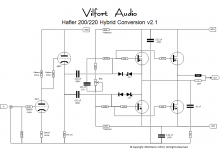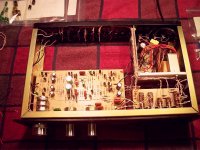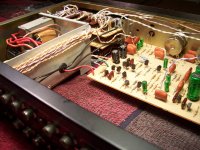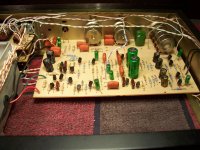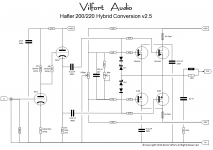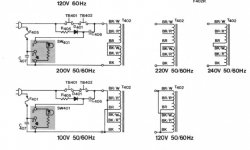amp-guy: I found that the good old Haflers are fairly good at having a nice symmetrical voltage (tested 4 so far) +/- 58V or so. So all you need to do for a low offset is to make sure the two 22K resistors are matched closely. This works of nicely because the BIAS circut made up of the 150 ohm resistor and 1K trimpot is floating. The 220uf cap makes sure that the voltage stays somewhat constant during high music passages. I get 40mV or less offset at the speaker terminals doing this.
You are right of course that this could just be dumb luck. So we can replace one of the 22K resistors in the BIAS voltage splitter with a 18K resistor and 5K trimpot in series. Make sure you measure the two in series adjust for 22K before powering up. Then after the amp is BIASed for 1.4V across the BIAS pot and the 150 ohm resistor and has run warm, you can adjust the 5K pot for less than 10mV on the speaker output terminals.
I may add this to the schematic - but for now matching the 22K resistors seem to work nicely (good to be lucky once in a while )
)
You are right of course that this could just be dumb luck. So we can replace one of the 22K resistors in the BIAS voltage splitter with a 18K resistor and 5K trimpot in series. Make sure you measure the two in series adjust for 22K before powering up. Then after the amp is BIASed for 1.4V across the BIAS pot and the 150 ohm resistor and has run warm, you can adjust the 5K pot for less than 10mV on the speaker output terminals.
I may add this to the schematic - but for now matching the 22K resistors seem to work nicely (good to be lucky once in a while
Hi pidigi referring to the 2sa1209 & 2sc2911, there are other possibilities of
course but I suggest you read post 465 page 47 and associated pages of mods leading up to the reasons why these devices were suggested, it is unwise to take such a mod out of context from the original write-up, as these
changes were to be the icing on the cake so to speak, and as you would have already observed from your readings there are already many many mods that can improve this amplifier without going this far. regards
Hi!
Thank you very much for your reply!
I have made a lot of mods on some DH-200 and built also some clones, all the passive components on the pcb are better than the original ones. I have changed all the capacitors, all the resistors are 1%MF, the input BJT are matched.
I'm very satisfied and now I'm trying to see if there is a way to have, as you say, the icing on the cake! I have ordered some fast diodes that I'd like to try, and I'm wondering also about the improvement had changing the drivers.
I'm planning to start some modifications on the circuit too (low memory input stage, cascoded Vas, etc) but I would prefer to see before what can be obtained without changing the circuit.
Ciao!
Paolo
Hafler 200/220 tube driver conversion
I promised to share as this project would progress. Version 2.0 was a great step in the right direction of applying good tried and true tube amp tradition to a MOSFET output stage:
- dead-simple topology (sounds better + one can wire the whole thing point to point)
- zero loop feed-back
- octal triodes
- Single Ended-like sound
- Detailed sound stage
- Natural sound (female vocals and S'es always smokes this out)
For those on this alias who have ever built a SE 300B based amp may have experienced that the tough part of building these simple amps is the yinging/yanging of parts for just the right sound. The SE topology will let you hear the sonic signature of each component. Don't laugh: I once auditioned every resistor I could lay my hands on. All values were held constant as was the tubes. Some sounded awful (surprise was that cheap old wire wound cement resistors sounded much better than metal film).
Same is true for caps. And the 'every part has its own sound' rule seems to apply to the Hafler conversion here as well.
In fact, when it came time to listen to version 2.0 of this Hafler Tube Conversion, I was prepared for a little bit of everything. It is always a good idea to start from the speakers and then work backwards when voicing an amp. But here we had 'half a Hafler' so the speakers, speaker cables and output MOSFETs were already there. So the next natural point of attention was the tubes themselves. Tried Russians here (they are cheap to replace if something goes wrong) - then when all was fine I tried vintage RCAs. Cathode resistor was Kiwame. Still, there was a nasty glare to the treble...
So I tried Haddock metal film as the cathode resistor for the cathode follower. Lot's of detail. But still the glare was there. Mills wire wound tamed it a bit. However, still a tendency toward bleeding ears... It started to smell like parasitic oscillation in the tube section. So out w/ the choke in the grid of the 6SN7 and in with a 5.6K carbon comp. Just to make sure, I added a 2.2K carbon comp to the grid of the 6SL7 as well. That did it! - Now the amp sounds sweet and relaxed. (see attached schematic)
Only goes to show that when the output of a tube amp is replaced with very precise MOSFETs one has to be careful optimizing each stage leading up to the output. No omitting of grid-stopper resistors! Of course this is also true for a good zero feedback tube amp design. Still, tube amps seem more forgiving that this hybrid...
For natural sound, the new version 2.1 now also has AB carbon comp in critical places. Will it work well w/ say Kiwame or Riken? Sure - but it'll sound diffrent. In fact you should roll your own ying/yang blend of components to your taste.
After all, having fun and having it your way that this hobby is all about.
D.
I promised to share as this project would progress. Version 2.0 was a great step in the right direction of applying good tried and true tube amp tradition to a MOSFET output stage:
- dead-simple topology (sounds better + one can wire the whole thing point to point)
- zero loop feed-back
- octal triodes
- Single Ended-like sound
- Detailed sound stage
- Natural sound (female vocals and S'es always smokes this out)
For those on this alias who have ever built a SE 300B based amp may have experienced that the tough part of building these simple amps is the yinging/yanging of parts for just the right sound. The SE topology will let you hear the sonic signature of each component. Don't laugh: I once auditioned every resistor I could lay my hands on. All values were held constant as was the tubes. Some sounded awful (surprise was that cheap old wire wound cement resistors sounded much better than metal film).
Same is true for caps. And the 'every part has its own sound' rule seems to apply to the Hafler conversion here as well.
In fact, when it came time to listen to version 2.0 of this Hafler Tube Conversion, I was prepared for a little bit of everything. It is always a good idea to start from the speakers and then work backwards when voicing an amp. But here we had 'half a Hafler' so the speakers, speaker cables and output MOSFETs were already there. So the next natural point of attention was the tubes themselves. Tried Russians here (they are cheap to replace if something goes wrong) - then when all was fine I tried vintage RCAs. Cathode resistor was Kiwame. Still, there was a nasty glare to the treble...
So I tried Haddock metal film as the cathode resistor for the cathode follower. Lot's of detail. But still the glare was there. Mills wire wound tamed it a bit. However, still a tendency toward bleeding ears... It started to smell like parasitic oscillation in the tube section. So out w/ the choke in the grid of the 6SN7 and in with a 5.6K carbon comp. Just to make sure, I added a 2.2K carbon comp to the grid of the 6SL7 as well. That did it! - Now the amp sounds sweet and relaxed. (see attached schematic)
Only goes to show that when the output of a tube amp is replaced with very precise MOSFETs one has to be careful optimizing each stage leading up to the output. No omitting of grid-stopper resistors! Of course this is also true for a good zero feedback tube amp design. Still, tube amps seem more forgiving that this hybrid...
For natural sound, the new version 2.1 now also has AB carbon comp in critical places. Will it work well w/ say Kiwame or Riken? Sure - but it'll sound diffrent. In fact you should roll your own ying/yang blend of components to your taste.
After all, having fun and having it your way that this hobby is all about.
D.
Attachments
unbalanced to balanced
Hi!
A friend of mine is using one of my clones, and he is wondering if it is possible to convert the unbalanced input of the DH200 to balanced. One option is using transformers, but I'm trying to see if it is possible to modify the circuit in order to avoid the transformers.
Wouldn't it be possible to use both "inputs" (Q1, Q5 and also Q2, Q6) of the input pair, adding to the nfb (between R20 and R21) the other hot connection of the balanced input?
Thanks!
Ciao
Paolo
Hi!
A friend of mine is using one of my clones, and he is wondering if it is possible to convert the unbalanced input of the DH200 to balanced. One option is using transformers, but I'm trying to see if it is possible to modify the circuit in order to avoid the transformers.
Wouldn't it be possible to use both "inputs" (Q1, Q5 and also Q2, Q6) of the input pair, adding to the nfb (between R20 and R21) the other hot connection of the balanced input?
Thanks!
Ciao
Paolo
The Hafler DH-200 is done. With advise from this thread and others, here is what I've done:
- Replaced all electrolytic capacitors.
- Mains were upgraded to 18,000 uF 80/100 VDC each caps (from 10,000 uF ea.)
- For bipolars, Nichicon MUSE ES were used
- For the other two, Nichicon and Xicon
- Installed 3 prong 14 awg power cord
- Grounded chassis
- Removed all grounds from chassis, ran them home via star topology to a replaced copper bus bar
- Input ground via 2.2 ohm resistors
- Replaced all input and outputs connectors with 24 K gold plated
- Used CAT6 data cable for input signals
- Bypassed all bipolar and main caps with .1 uF film caps
- Bypassed mains with 470 uF 100 VDC and .1 uF film caps
- Removed output tranny grounds, tied them to ground bus
- Installed an NTC 5 ohm thermistor as inrush current limiter
- Installed a class x capacitor accross the main AC line
- Set bias to 275 mA
- DC offset L 11 mV R 70 mV
Sound is awesome even with caps not broken in. Very quiet and powerful. Nice laid back disposition like that of tubes. Love it.
Thanks for all your help.
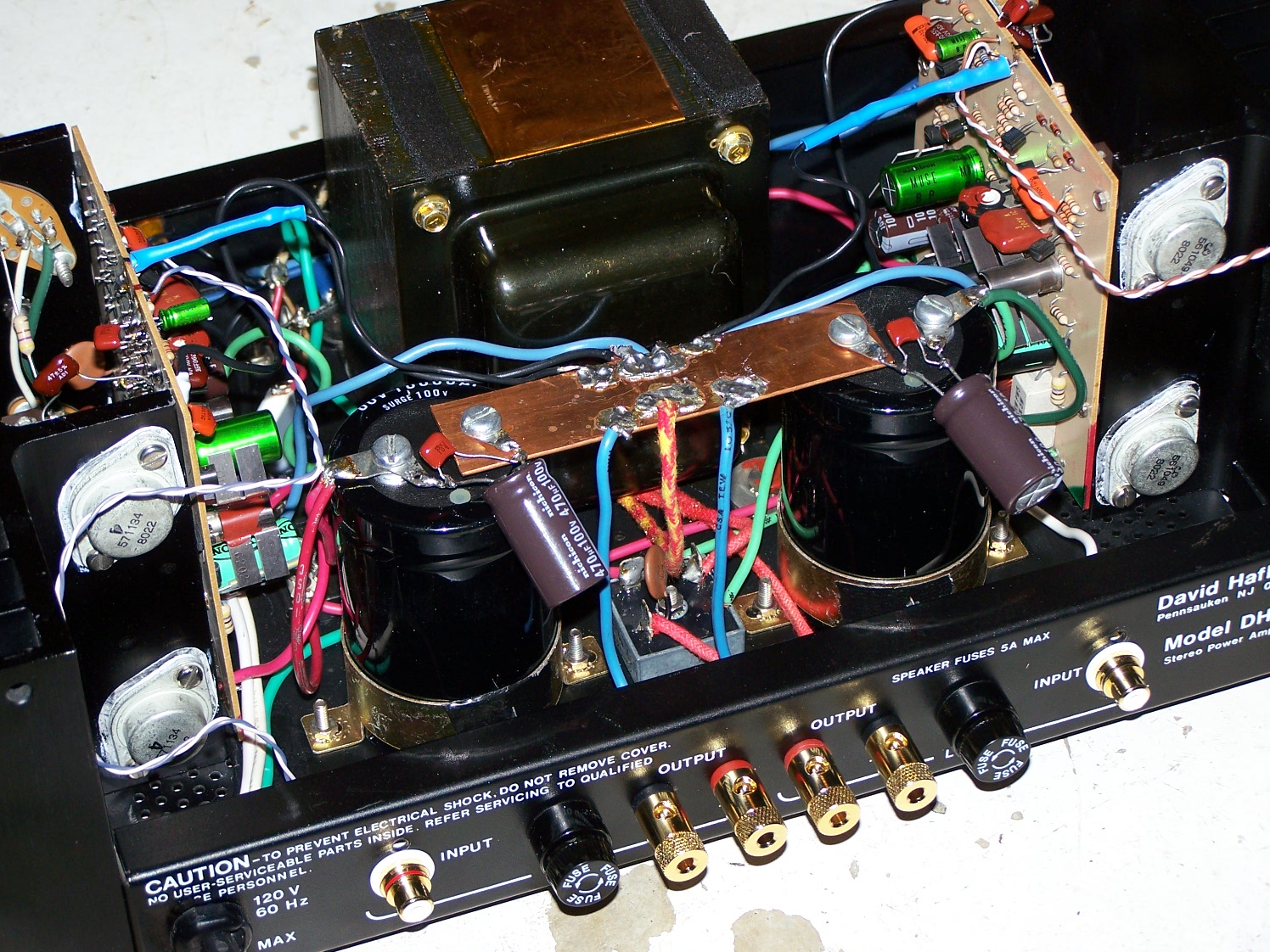
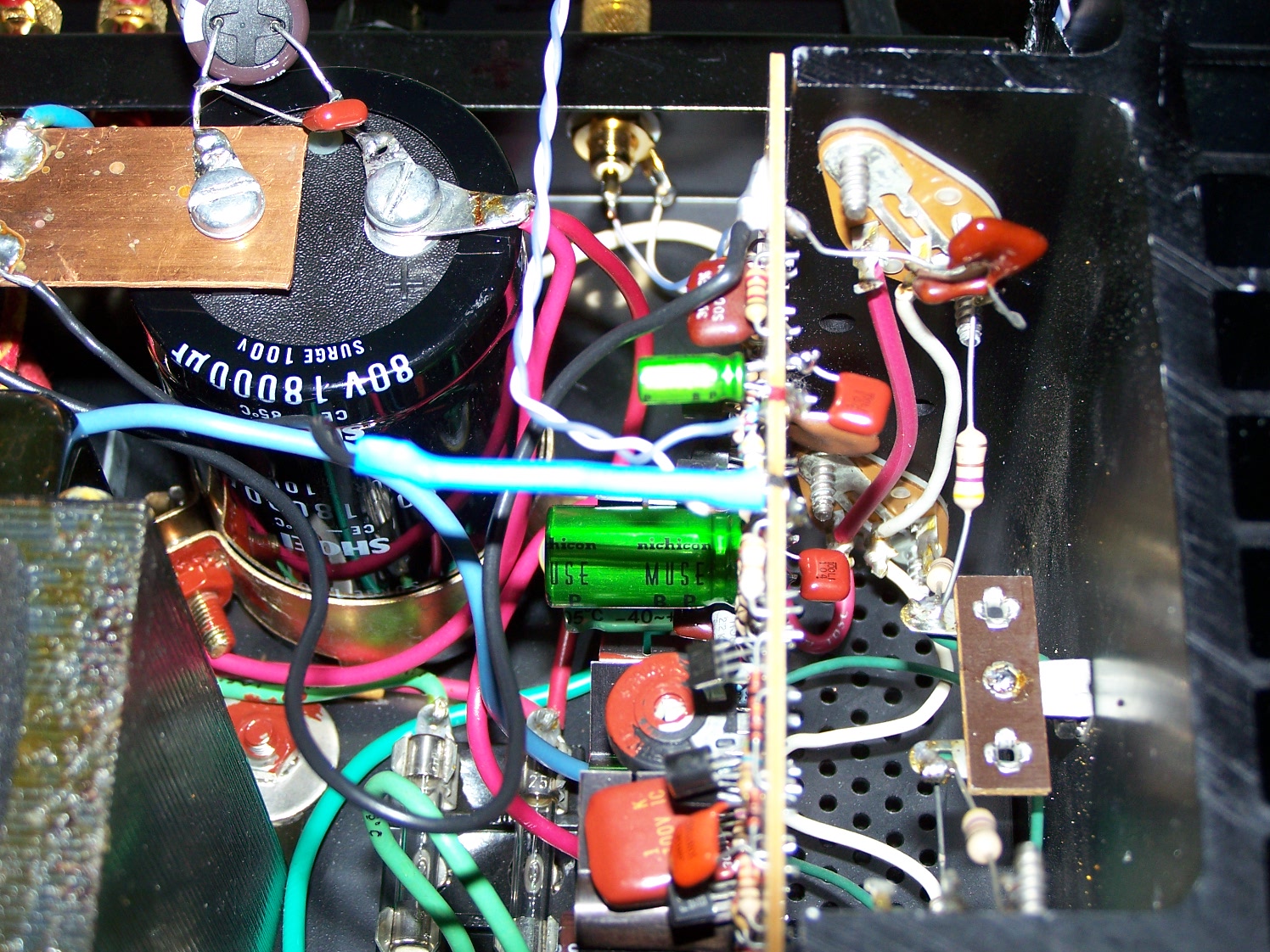
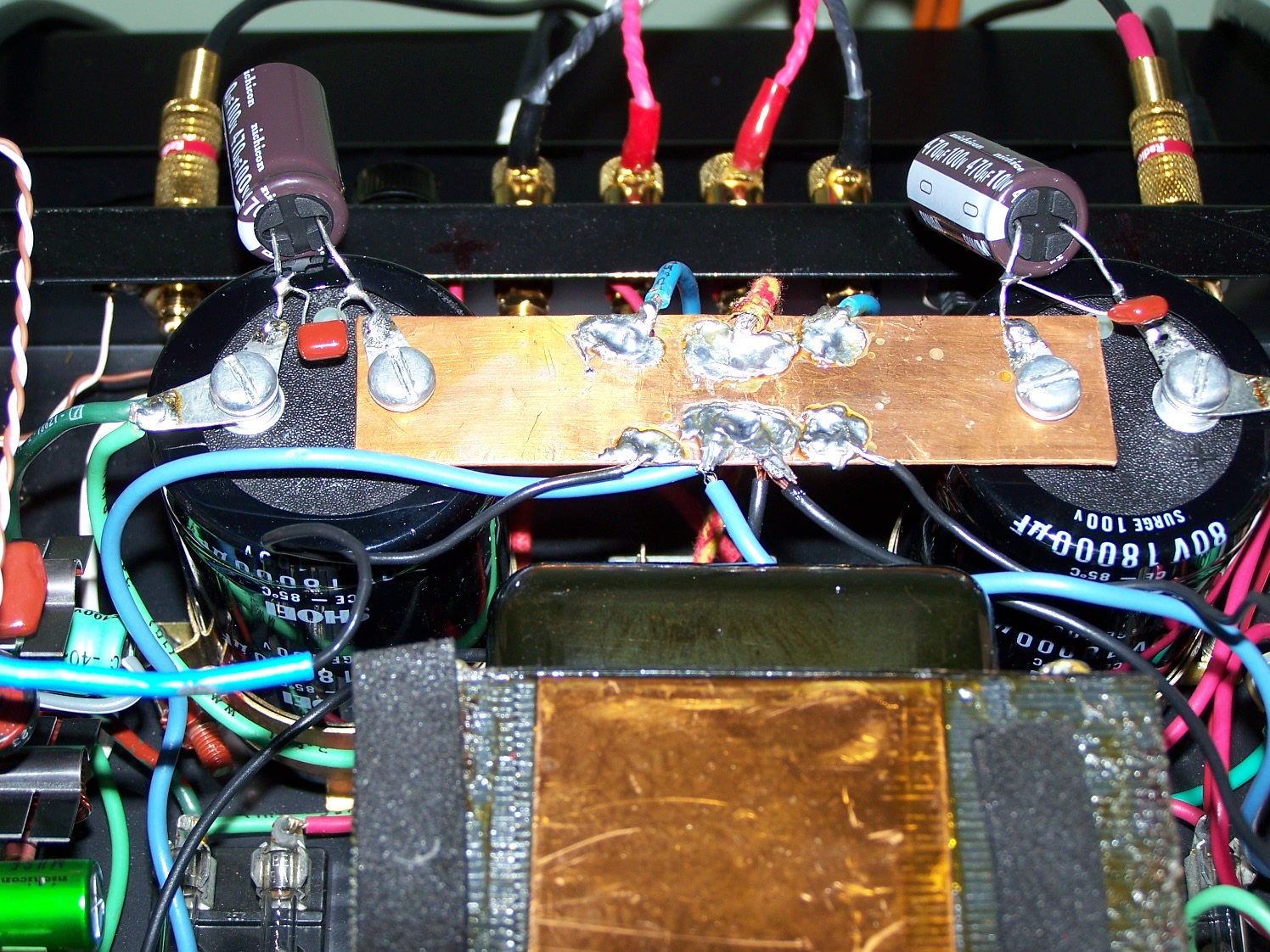
Here you can see output transistors black ground wire towards left side of pic. I drilled a hole and fed the film cap through it to meet the wire.
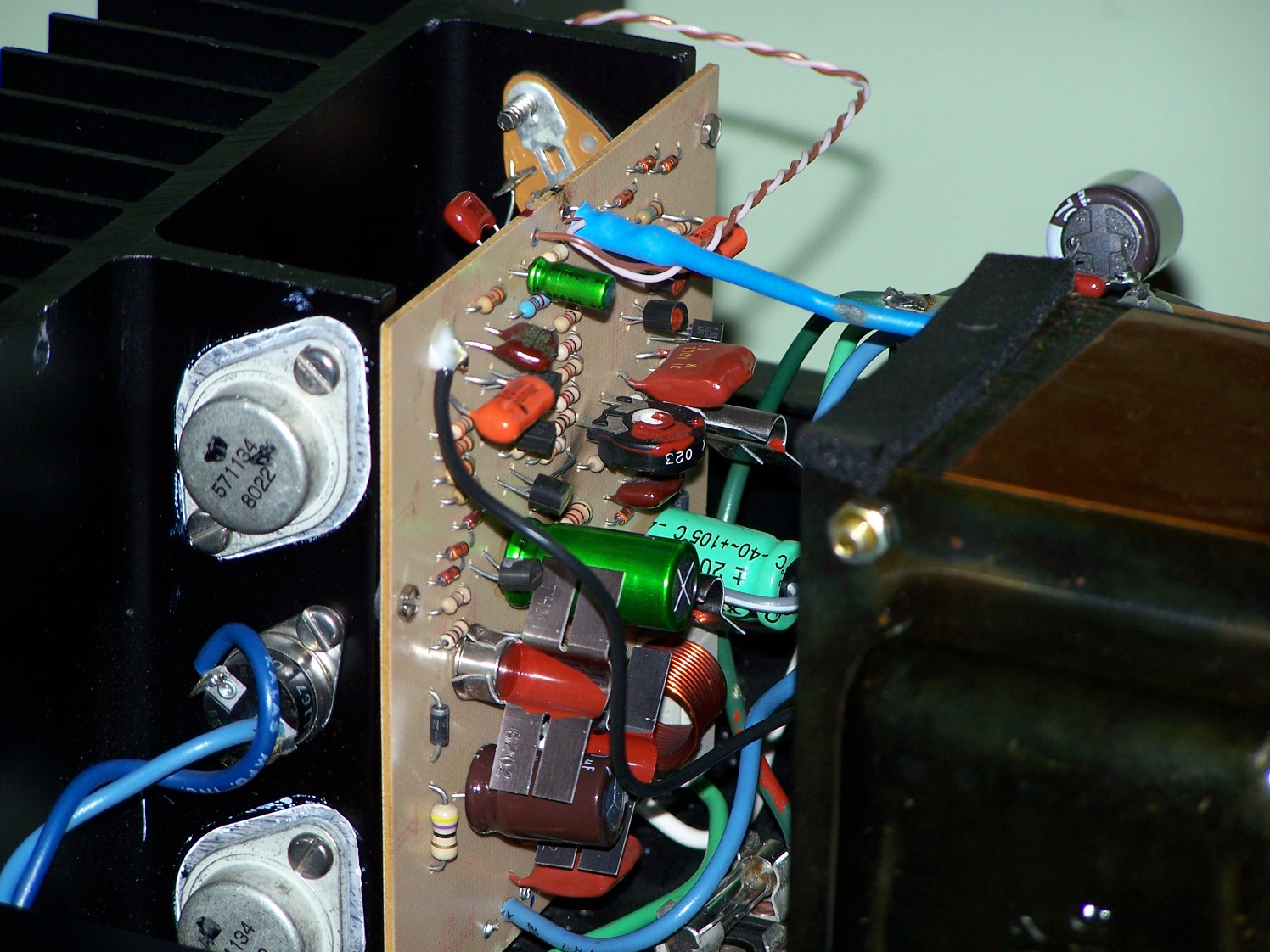
Here you can see the CAT 6 input wire and the main caps bypassed with a .1 uF film cap and a 470 uF 100V electrolytic. If someone has a good grasp of what these bypasses do, please say on. I have read Tamara's and Wong's white papers...
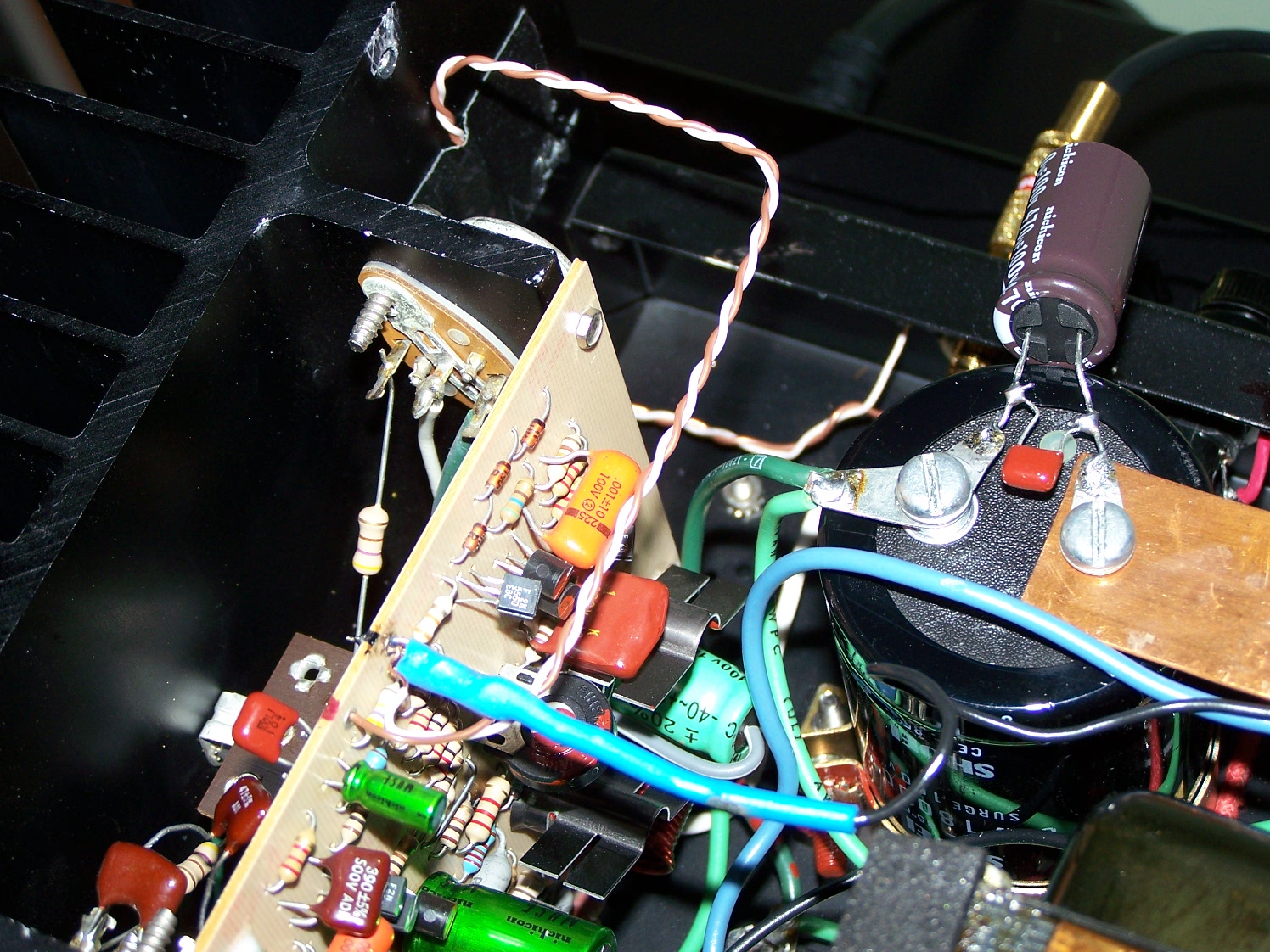
If anyone is interested in hearing this amp and the DH-101 preamplifier that I did with CAT6, I uploaded some recorded MP3s on my site: virtual audition
Kind of a virtual audition if you will, but you'll get an idea how it well it turned out.
Here is a pic of the DH-101:
Attachments
Great work! Congrats!
FWIW, I have done something very similar to the DH-200 monoblocks I am running here. For me, the last little bit of improvement was to replace the 10 uF DC input blocking electrolytic with an 8 uF polyprop.
If you dig back though my posts (2 years ago?) you will find how one can jury rig a way to inject a small amount of DC at the input to null out any DC offset. This was a suggestion posted in TAA back in the early 80s by Borbely himself. If you don't find it let me know and I will re-post.
I have modded both the DH-200 and DH-220, even to monoblock both. I prefer the sound of the DH-200 over that of the DH-220, which seems a little too sedate in sound and as if something is slightly missing. My reference amp here is a monoblocked DH-200 (each channel on a separate chassis) with an upped drive current to the final driver transistors (again in previous posts, thanks to Fab, the expert who posted here a lot in the past).
Whatta' hobby!
Later...........
FWIW, I have done something very similar to the DH-200 monoblocks I am running here. For me, the last little bit of improvement was to replace the 10 uF DC input blocking electrolytic with an 8 uF polyprop.
If you dig back though my posts (2 years ago?) you will find how one can jury rig a way to inject a small amount of DC at the input to null out any DC offset. This was a suggestion posted in TAA back in the early 80s by Borbely himself. If you don't find it let me know and I will re-post.
I have modded both the DH-200 and DH-220, even to monoblock both. I prefer the sound of the DH-200 over that of the DH-220, which seems a little too sedate in sound and as if something is slightly missing. My reference amp here is a monoblocked DH-200 (each channel on a separate chassis) with an upped drive current to the final driver transistors (again in previous posts, thanks to Fab, the expert who posted here a lot in the past).
Whatta' hobby!
Later...........
Hafler 200/220 tube conversion update
This thread has been a little quiet lately so I figured it was time to post an update to my Hafler tube conversion project.
Today an old 220 arrived at my door from Ebay. It was a completely un-modified factory wired job so it gave me a nice chance to hear what a "clean" Hafler sounded like... Well what is there to say: it sounded a bit congested, un-elegant, clumsy and chalky... Sure, it likely could benefit from a re-cap but I cannot help feeling that the whole high open loop gain/loop feedback thing is messing up things.
I immediately hooked my Hafler tube mod up again and played the same CDs... Now, this was better: effortless, deep and wide sound stage, bass slam and silky highs.
This octal triode MOSEFET combo is becoming very easy to live with. It also seems very stable. I have run the amp for 10 days straight now and BIAS is rock solid. Sound wise the amp really started opening up after having been on for 3 days. I also noticed that tube rolling makes a huge difference. Russian surplus tubes sounded raw and harsh. The best combo was running Sylvania 6SL7 w/ GE 6SN7.
In case anyone out there wants to build this sweet little amp from an old Hafler (or build it from scratch) here is a cleaner and safer version of the schematic (version 2.5).
Cheers,
D.
PS: yes, all the parts do fit nicely in the chassis with a little finesse. I will post a pic later.
This thread has been a little quiet lately so I figured it was time to post an update to my Hafler tube conversion project.
Today an old 220 arrived at my door from Ebay. It was a completely un-modified factory wired job so it gave me a nice chance to hear what a "clean" Hafler sounded like... Well what is there to say: it sounded a bit congested, un-elegant, clumsy and chalky... Sure, it likely could benefit from a re-cap but I cannot help feeling that the whole high open loop gain/loop feedback thing is messing up things.
I immediately hooked my Hafler tube mod up again and played the same CDs... Now, this was better: effortless, deep and wide sound stage, bass slam and silky highs.
This octal triode MOSEFET combo is becoming very easy to live with. It also seems very stable. I have run the amp for 10 days straight now and BIAS is rock solid. Sound wise the amp really started opening up after having been on for 3 days. I also noticed that tube rolling makes a huge difference. Russian surplus tubes sounded raw and harsh. The best combo was running Sylvania 6SL7 w/ GE 6SN7.
In case anyone out there wants to build this sweet little amp from an old Hafler (or build it from scratch) here is a cleaner and safer version of the schematic (version 2.5).
Cheers,
D.
PS: yes, all the parts do fit nicely in the chassis with a little finesse. I will post a pic later.
Attachments
Just replaced RCAs,what else can i do.Hi all, i am new to this Forum, i have been following this Hafler thread for quite some time with lots of interest. Just woundering if Mr Whaleman could give us a discription of what he did to his DH-101.Thanks
Picasa Web Albums - 11333668591060104... - Desktop
The RCAs look great, good job!
Oh, those beautiful IC caps.... For the Lord's sake man, if it sounds good leave it alone. Clean up the pots if you must and be done with it.
If you do decide to mess with caps, start in the power supply and be prepared for night and day changes in the sound. You may find yourself fiddling with tone controls for the first time in your life, like I did with my 110.
Fair warning,
Scott
Oh, those beautiful IC caps.... For the Lord's sake man, if it sounds good leave it alone. Clean up the pots if you must and be done with it.
If you do decide to mess with caps, start in the power supply and be prepared for night and day changes in the sound. You may find yourself fiddling with tone controls for the first time in your life, like I did with my 110.
Fair warning,
Scott
You are right, I am very happy with the way it sounds, leave it alone and be done with it. Thanks for the advice.The RCAs look great, good job!
Oh, those beautiful IC caps.... For the Lord's sake man, if it sounds good leave it alone. Clean up the pots if you must and be done with it.
If you do decide to mess with caps, start in the power supply and be prepared for night and day changes in the sound. You may find yourself fiddling with tone controls for the first time in your life, like I did with my 110.
Fair warning,
Scott
Dh-200
Hi, here are some images of the work I did on my DH-200. Found this Amp in brother in-law garage rusting away. After replacing slow blow fuse it had a bad cracking noise in left channel, bad transistor or cap, I don’t know. Right channel working ok, dc offset was 160mvolts, so I decided to rebuild both driver boards. Dc offset is now at L 7mv R 30mv Bias set to 250ma. The plan was to do the star grounding system and NTC thermistor for inrush current that Slowhands suggested. But the amp sounds so good I won’t bother. I will do the thermistor. I find myself listening to my Hafler now instead of my NAD system, bass is lot more puncher. Couldn’t have done this without the info I found on this thread. Thanks to you all. Walter
Picasa Web Albums - 11333668591060104... - Documents
Hi, here are some images of the work I did on my DH-200. Found this Amp in brother in-law garage rusting away. After replacing slow blow fuse it had a bad cracking noise in left channel, bad transistor or cap, I don’t know. Right channel working ok, dc offset was 160mvolts, so I decided to rebuild both driver boards. Dc offset is now at L 7mv R 30mv Bias set to 250ma. The plan was to do the star grounding system and NTC thermistor for inrush current that Slowhands suggested. But the amp sounds so good I won’t bother. I will do the thermistor. I find myself listening to my Hafler now instead of my NAD system, bass is lot more puncher. Couldn’t have done this without the info I found on this thread. Thanks to you all. Walter
Picasa Web Albums - 11333668591060104... - Documents
I just got a Hafler DH220, unfortunately, the power supply input is 110VAC and I live in the Philippines, which is a 220VAC country.
I intend to replace the EI transformer with a toroidal. Does anybody knows what are the secondary voltage of the transformer and how many VA toroid should i get?
Thanks.
I intend to replace the EI transformer with a toroidal. Does anybody knows what are the secondary voltage of the transformer and how many VA toroid should i get?
Thanks.
I intend to replace the EI transformer with a toroidal. Does anybody knows what are the secondary voltage of the transformer and how many VA toroid should i get?
The DH220 service manual is available online - Google is your friend.
The manual doesn't state the VA and voltage specs for the transformer, though it does give quiescent voltages from which we can learn quite a bit.
The output transistor supply sits at +/-65.4V with no signal. Working backwards from this figure, the light load RMS output voltage will be 45.7V, with 5% regulation you'll need a 43V secondary.
The VA rating is harder to determine - the consumption specs show a maximum of 840VA, EI core transformers are less efficient than toroids. So I'd go for a 750VA. The form factor of such a toroid will be quite different to the EI - do you think it will still fit in the case?
One other thing to watch with toroids is the capacitive coupling to the mains side - if you're getting a custom one, specify an electrostatic interwinding shield.
The manual doesn't state the VA and voltage specs for the transformer, though it does give quiescent voltages from which we can learn quite a bit.
The output transistor supply sits at +/-65.4V with no signal. Working backwards from this figure, the light load RMS output voltage will be 45.7V, with 5% regulation you'll need a 43V secondary.
The VA rating... ...840VA
One other thing to watch with toroids is the capacitive coupling to the mains side - if you're getting a custom one, specify an electrostatic interwinding shield.
how much of this data applies to the XL280?
I just got a Hafler DH220, unfortunately, the power supply input is 110VAC and I live in the Philippines, which is a 220VAC country.
I intend to replace the EI transformer with a toroidal.
Other than the mains voltage, is there another reason you want to replace the EI transformer with a toroidal? It might be easier to get an isolation transformer which will step the mains voltage down to 110.
I just got a Hafler DH220, unfortunately, the power supply input is 110VAC and I live in the Philippines, which is a 220VAC country.
I intend to replace the EI transformer with a toroidal. Does anybody knows what are the secondary voltage of the transformer and how many VA toroid should i get?
Thanks.
I thought there is a dual winding transformer that simply requires the change of a couple of jumpers.
Attachments
Last edited:
- Home
- Amplifiers
- Solid State
- Hafler DH-200/220 Mods
